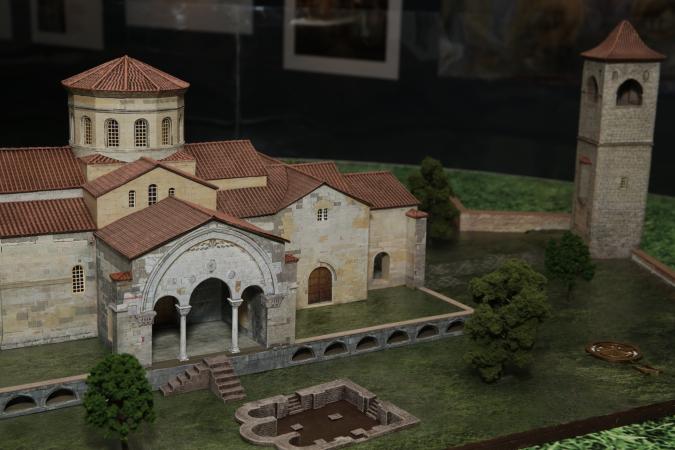
IF YOU SHOULD SAIL TO TREBIZOND OR BE CONVERTED…

Grab your last chances to visit “Byzantium’s Other Empire: Trebizond” at Koç University’s Research Center for Anatolian Civilizations on Istiklal Caddesi, Istanbul. The exhibition shows the Hagia Sophia Church in this Black Sea city, which was a museum between 1968 and 2013, but was reconverted into a mosque, with the restored frescoes covered.
If you should sail to Trebizond, or die,
Or cry another name in your first sleep,
…I’d clutch my breast and weep.
These are the first stanzas of Dorothy Parker’s poem, “The Immortals,” where she aptly and poisonously describes the two lovers with a knack for drama. The punch line, the signature of the love-weary Parker, comes at the end:
Therefore the mooning world is gratified,
Quoting how prettily we sigh and swear;
…
And though we lie forever as enemies,
Shall rank with Abelard and Heloise.
There is something of the same “illusion vs. reality” in the Western perception of Trebizond. The forgotten Byzantium Empire with its long and musical name, became an object of fantasy for the Western romantics throughout the ages – only to be confronted with a “second-rate maritime city.”
“It is the country of my dreams from my early years and I must breathe its air,” 18th century historian Jakob Fellmeyer said. His focus was not the “gritty trading city” but the orientalist fantasy that stood between the stormy Black Sea and the rocky Pontus Mountains.
The “empire” of Trebizond founded in 1204 was an empire in name only, with just a strip of land, writes Professor Dr. Antony Eastmond, dean of the Courtauld Institute-University of London who curated a major exhibition on Trebizond. The strategic position, which easily created a harbor for fleets on their way to naval wars, attracted the attention of the Roman and Byzantine emperors and its status as a trading city engraved Trebizond in western mediaeval consciousness, according to Eastmond: “It was a major port, marking the first point where goods travelling West along the Silk Road from China would be put abroad a ship for easier transport.”
Distance, which made the city beyond the reach of most Europeans, helped the legend of Trebizond to grow. Trebizond, the myth, was the city of hot-tempered, bewitching women (think of Medea), of brave and autocratic emperors (think of Mehmet II, as portrayed on a Venetian wedding chest of 1460s, as standing between two capitals, Constantinople and Trebizond) and of intrigues. No wonder the real city, Trabzon appeared pale in comparison.
Yet, the city today can still boast that it has maintained some of the relics of its past. Again according to Antony Eastmond, Trebizond had a vibrant and unique culture that is visible in the buildings, paintings and metalwork that was made in the city. Its emperors commissioned great monuments, including the Hagia Sophia of Trebizond –a 13th century church that is the best preserved monument of the empire. The church itself was built by Emperor Manuel I in the 13th century and the tower at the end – the famous Tower of Trebizond – was built two centuries later. The Christian Orthodox church was at the heart of a monastic complex.
It did not have an easy life. By 1700’s, it had turned into a shabby and much-destroyed mosque. Ironically, the monastery continued to be used by monks as late as 1701, when French botanist and author Joseph Pitton de Tournefort found them still in residence. In mid-1800’s, its narthex, a separate place at the North of the church which was used for baptism of new Christians, functioned as a stable. When the remaining building was restored as a mosque in 1880s, the – remaining – Wall paintings were covered in plaster.
The restoration, funded by the Russell Trust fund, came in 1959. The Fund was already involved in various archeological projects around Turkey and Talbot Rice, who initiated the expedition, established a small team of Turkish and English experts headed by David Winfield. The slow and laborious cleaning project revealed images of a sympathetic Christ, with the word “philanthropos” (lover of mankind). Surrounding the dome figure of Christ is, according to Eastwood, one of the wonders of the church: an adoring choir of angels who bow before him. Equally entrancing is the frieze that tells the Fall of Men – a narrative which starts with the image of Eve created from Adam’s rib – not with her taking the Forbidden Fruit.
The restored church became a museum in 1968. Then, in 2012, Turkish Directorate General of Religious Affairs (Diyanet) sued the Ministry of Culture (responsible for Museums) of “illegally occupying” the church for four decades. The Diyanet won the case the former church was partially converted into a mosque, with some of frescoes veiled and the floor covered by a carpet.
The large photos of the friezes are part of the exhibition “Byzantium’s Other Empire: Trebizond” at Koç University’s Research Center for Anatolian Civilizations. The exhibition, curated by Prof. Antony Eastmond, draws extensively on the photography and drawing archives of David and June Winfield, held in the Conway Library at the Courtauld Institute of Art in London. The exhibition also contains Rice’s photographs in the 1920’s. A few photos taken by other experts who visited Trabzon, notably Gabriel Millet and Fyodor Uspenskii are also displayed, as well as a3D model of Hagia Sophia. The exhibition will be open until September 18.
For further info: https://anamed.ku.edu.tr/en/byzantiums-other-empire-trebizond-0
-
Previous Post
‘Other’ victims of Turkey: Hande, Aslı and R.D.
-
Next Post
September has come and it is hers…



